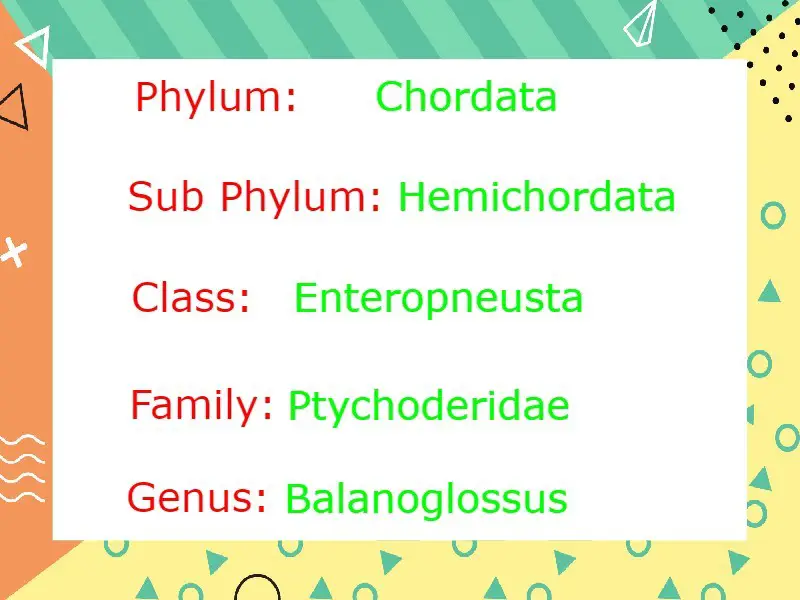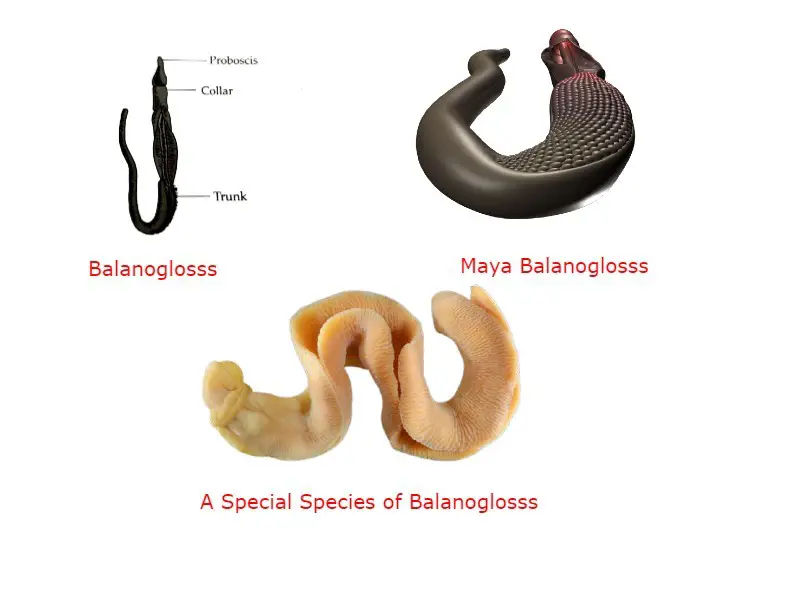Now we are going to discuss what is Balanoglossus, what is its position in the animal kingdom, and the origin of the name Balanoglossus.
Table of Contents
What is Balanoglossus:
Balanoglossus is a member of Hemichordata and they are marine, they are considered as primitive Chordata thought now they are placed in a separate phylum of invertebrates and they show similarity with Echinodermata.
They are also known as acorn worm or tongue worm, their body is soft and vermiform. Under Hemichordata Balanoglossus is a very important genus and other related genera are Saccoglossus, Glossobalanus, Spengelia.

Systematic Position of Balanoglossus:
Now we will focus on the position of Balanoglossus in the animal kingdom and their relationship with other groups of animals.
Traditionally they are considered as a member of phylum Chordata and under the subphylum Hemichordata but recently they are placed in a separate phylum of invertebrates, Hemichordata.
Under subphylum Hemichordata they are placed in class Enteropneusta and family Ptychoderidae.
Origin of Name Balanoglossus:
Genus Balanoglossus is close to two Greek words, balanos and glossus, balanos is the term used for the fruit of the oak, acorn, and term glossus represents tongue.
The proboscis of Balanoglossus project from the collar like an acorn nut and for this reason Balanoglossus is also known as acorn worm. The proboscis, collar, and genital wings have resemblance with ox tongue and due to these similarities, they are also known as tongue worms or ox tongues.
Balanoglossus clavigerous is a very important member of the genus Balanoglossus which was recorded by Delle Chiaje in 1829 and the name was also given by Delle Chiaje.

Detailed Information on Phylum Chordata
Geographical Distribution of Balanoglossus:
Balanoglossus is not confined to any specific geographical area, it is available in almost all geographical areas and they are marine. It is true that some species are only confined to a certain geographical area, the most abundant in the tropical and subtropical sea and approximately this genus has 20 species.
In the Mediterranean and the British Isles, the most abundant species of Balanoglossus is Balanoglossus clavigerous, in Japan Balanoglossus misakiensis species available, Balanoglossus gigas is abundant in Brazil, Balanoglossus capensis abundant in South Africa, in Australia Balanoglossus australiensis is most abundant.
Habitat of Balanoglossus:
Balanoglossus generally live in the coastal region where the water level is not deep, some of them live in deep water and they mostly live inside burrows. The shape of burrows is special in some species in Balanoglossus clavigerous the burrows is U shape tube-like while in the case of some species the shape of burrows is twisted.
The burrows show special features in Balanoglossus, the U-shaped burrows have two limbs, anterior limbs, and posterior limbs, anterior limbs open into outside in funnel-shaped opening and the anterior limbs have branching which also open outside through the funnel-shaped opening. Spirally coiled fecal matter of Balanoglossus deposit at the opening of the posterior limbs of the burrows.
The burrows are made in sand or mud so there should be any precautions that will protect the animals against collapsing the burrows, the mucous secreted by the skin gland line the interior wall of the burrows which makes the burrow wall smooth and solid. Balanoglossus have a foul smell which gives them protection against different predators.
Food Habits of Balanoglossus:
Balanoglossus live in sand or mud and they take food from the sand or mud, they directly engulf the sand and mud from which they feed on different types of microorganisms, diatoms, protozoa, organic material.

Movement in Balanoglossus:
Balanoglossus generally do not require much movement but after tides, they protrude their anterior part outside of the burrows, other times the proboscis show different types of movement to make the burrows.
Reproduction in Balanoglossus:
Balanoglossus can show regeneration from their body parts, their primary mode of reproduction is through sexual reproduction. Balanoglossus is dioecious, male and female Balanoglossus live in different burrows and release their gametes into the water, fertilization occur in water, the life cycle has free-swimming ciliated tornaria larvae.
Reference:
Hi Everyone!!! Welcome to Imaluop. Imaluop always try to learn some new and he want to share to other people. Here we will try to learn various topics on Science, specially on Biological Sciences.
